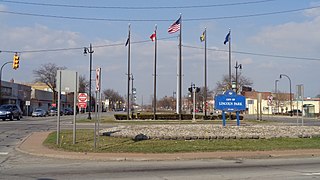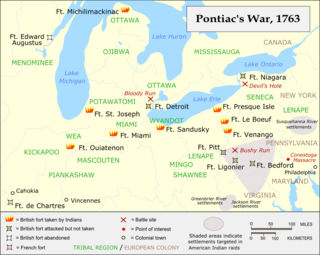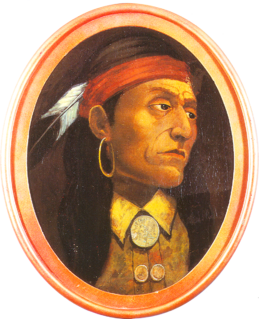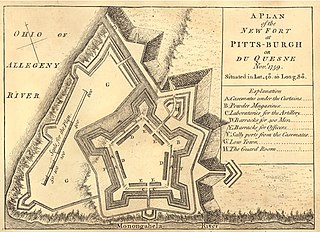
Lincoln Park is a city in Wayne County in the U.S. state of Michigan. The population was 38,144 at the 2010 census, down from 40,008 at the 2000 census. With a population density of 6,476.1/sq mi (2,500.4/km2) at the 2010 census, Lincoln Park is the second most-densely populated municipality in the state after Hamtramck.

The Royal Proclamation of 1763 was issued by King George III on 7 October 1763. It followed the Treaty of Paris (1763), which formally ended the Seven Years' War and transferred French territory in North America to Great Britain. The Proclamation forbade all settlements west of a line drawn along the Appalachian Mountains, which was delineated as an Indian Reserve. Exclusion from the vast region of Trans-Appalachia created discontent between Britain and colonial land speculators and potential settlers. The proclamation and access to western lands was one of the first significant areas of dispute between Britain and the colonies and would become a contributing factor leading to the American Revolution. The 1763 proclamation line is similar to the Eastern Continental Divide's path running northwards from Georgia to the Pennsylvania–New York border and north-eastwards past the drainage divide on the St. Lawrence Divide from there northwards through New England.

Pontiac or Obwaandi'eyaag was an Odawa war chief known for his role in the war named for him, from 1763 to 1766 leading Native Americans in an armed struggle against the British in the Great Lakes region due to, among other reasons, dissatisfaction with British policies. It followed the British victory in the French and Indian War, the American front of the Seven Years' War. Pontiac's importance in the war that bears his name has been debated. Nineteenth-century accounts portrayed him as the mastermind and leader of the revolt, but some subsequent scholars argued that his role had been exaggerated. Historians today generally view him as an important local leader who influenced a wider movement that he did not command.
The Battle of Windsor was a short-lived campaign in the eastern Michigan area of the United States and the Windsor area of Upper Canada. A group of men on both sides of the border, said of themselves "Patriots", formed small militias in 1837 with the intention of seizing the Southern Ontario peninsula between the Detroit and Niagara Rivers and extending American-style government to Canada. They based groups in Michigan at Fort Gratiot, Mount Clemens, Detroit, and Gibraltar. The Patriots were defeated by British and American government forces, respectively.

Pontiac's War was launched in 1763 by a loose confederation of Native Americans dissatisfied with British rule in the Great Lakes region following the French and Indian War (1754–1763). Warriors from numerous nations joined in an effort to drive British soldiers and settlers out of the region. The war is named after Odawa leader Pontiac, the most prominent of many Indigenous leaders in the conflict.

Henry Bouquet was a Swiss mercenary who rose to prominence in British service during the French and Indian War and Pontiac's War. He is best known for his victory over a Native American force at the Battle of Bushy Run, lifting the siege of Fort Pitt during Pontiac's War. During the conflict Bouquet gained lasting infamy in an exchange of letters with his commanding officer, Jeffery Amherst, who suggested a form of biological warfare in the use of blankets infected with smallpox which were to be distributed to Native Americans. Despite this indictment historians have praised Bouquet for leading British forces in several demanding campaigns on the Western Frontier in which they "protected and rescued" settlers from increasingly frequent attacks.

The Battle of Bloody Run was fought during Pontiac's War on July 31, 1763 on what now is the site of Elmwood Cemetery in the Eastside Historic Cemetery District of Detroit, Michigan. In an attempt to break Pontiac's siege of Fort Detroit, about 250 British troops attempted to make a surprise attack on Pontiac's encampment.

Fort Pontchartrain du Détroit or Fort Detroit (1701–1796) was a fort established on the north bank of the Detroit River by the French officer Antoine de la Mothe Cadillac in 1701. In the 18th century, French colonial settlements developed on both sides of the river, based on the fur trade, missions and farms.

The Battle of Devil's Hole, also known as the Devil's Hole Massacre, was fought near Niagara Gorge in present-day New York state on September 14, 1763, between a detachment of the British 80th Regiment of Light Armed Foot and about 300 Seneca warriors during Pontiac's Rebellion (1763–1766). The Seneca warriors killed 81 British soldiers and wounded 8 before the British managed to retreat.

The Siege of Fort Detroit was an ultimately unsuccessful attempt by North American Indians to capture Fort Detroit during Pontiac's Rebellion. The siege was led primarily by Pontiac, an Ottawa chief and military leader. This rebellion would be one of the catalysts that hastened the declaration of the Proclamation of 1763 which would eventually precipitate the events leading to the American Revolution.

The Siege of Fort Pitt took place during June and July 1763 in what is now the city of Pittsburgh, Pennsylvania, United States. The siege was a part of Pontiac's War, an effort by Native Americans to remove the British from the Ohio Country and Allegheny Plateau after they refused to honor their promises and treaties to leave voluntarily after the defeat of the French. The Native American efforts of diplomacy, and by siege, to remove the British from Fort Pitt ultimately failed.
Pontiac is a provincial electoral district in the Outaouais region of Quebec, Canada that elects members to the National Assembly of Quebec. It includes the Aylmer sector of the city of Gatineau as well as the municipalities of Pontiac, Shawville, Fort Coulonge, Sheenboro, Bryson and Waltham.
The Battle of Pelee Island took place during the Patriot War along what is now the Michigan-Ontario border in 1838 involving small groups of men on each side of the border seeking to "liberate" Upper Canada from the British.
Fort Sandoské was a French military fort, built about 1750 on what is now called the Marblehead Peninsula on the northern side of Sandusky Bay in Ohio, near the traditional portage place from the bay to Lake Erie.
Battle of River Canard was the site of an engagement between British and American forces on July 16, 1812, during the War of 1812. Though it is called the "Battle" of River Canard, it should be thought of as a series of skirmishes. The defined Battle of River Canard is the first skirmish that occurred in a series of small fights, and was the first example of armed conflict in Canada resulting from the War of 1812. An American force of 280 men under Colonels Cass and Miller skirmished with a British force under Lieutenant-Colonel T.B. St. George, consisting of the British 41st Regiment, Indians and Canadian militia, near the bridge. A generalized account of the battle would model after the outcome of the War of 1812, the Battle of Canard technically yielded no winner. American forces drove British soldiers back into a nearby fort, Fort Malden, but the next day Americans abandoned the ground gained. However, a more specific account suggests American victory. Before the battle, American General William HulI ordered Colonel Cass to scout for British troops. Cass encountered British outposts, and quickly maneuvered to flank the British allied forces consisting of members of the 41st Regiment, under the command of Colonel T.B. St. George. Cass's quick flank proved successful, and forced the British troops to retreat to Fort Malden. Cass's flank also opened a route to British controlled Amherstburg, but aware of the distance between the American main force and the troops that won the battle, General Hull ordered American retreat. During the first skirmish, two British soldiers, James Hancock and John Dean were captured. Hancock would die of his wounds later in the day, becoming the first British casualty of the war. Dean was taken prisoner to Detroit where his left arm was amputated due to wounds. He would be liberated with the capture of Fort Detroit by the British one month later. Both Hancock and Dean were commended by the presiding administrator, Sir Isaac Brock. By proving a skilled soldier and administrator, Sir Isaac was commonly known as "The Hero of Upper Canada." Sir Isaac died later that year, on October 13, 1812, and is remembered as a war hero. A second skirmish took place at Turkey Creek in present day LaSalle, where 4 Americans were killed and dismembered by First Nations allied to the British.

Turtleheart was a Delaware (Lenape) principal warrior and chief who lived during the French and Indian Wars, and Pontiac's War. He and Lenape Chief Killbuck represented the Delaware Nation at the Treaty of Fort Stanwix in 1768.









